On one hand, the deadlift is as simple and straightforward as “pick the heavy bar up off the ground and stand up.” On the other hand, the deadlift is an intricate series of muscular coordinations, involving muscles from your ankles and thighs to your abdomen and lower back to your shoulders, wrists, and hands. Because … Read more
The post How to Do the Deadlift for Strength and Muscle appeared first on Breaking Muscle.
On one hand, the deadlift is as simple and straightforward as “pick the heavy bar up off the ground and stand up.” On the other hand, the deadlift is an intricate series of muscular coordinations, involving muscles from your ankles and thighs to your abdomen and lower back to your shoulders, wrists, and hands.
Because the deadlift requires so many muscle groups to work together, it gives you the potential to move significant weights. Putting all those moving parts under all that stress is also a great way to build some serious muscle size and strength.
Here’s a complete guide to mastering the deadlift and using this fundamental movement to build total-body strength and a more muscular back and legs.
- How to Do the Deadlift
- Deadlift Mistakes to Avoid
- Benefits of the Deadlift
- Muscles Worked by the Deadlift
- Who Should Do the Deadlift
- How to Program the Deadlift
- Deadlift Variations
- Deadlift Alternatives
- Frequently Asked Questions
Detailed Deadlift Technique Video
Coach Shane Trotter explains an eight-point checklist covering the most essential technique tips to perform a strong, safe deadlift. Take the time to watch the video and then learn more in-depth steps throughout the article.
How to Do the Deadlift
Deadlift technique is sometimes oversimplified to “dip, grip, and rip”, meaning all you need to worry about is getting your body down to the bar, grabbing it, and pulling it up hard.
That succinct three-step approach leaves out more than a few key details that can mean the difference between a good lift and an incomplete lift or, more importantly, a productive lift and one that leads to injury.
Here’s a more in-depth and more useful breakdown of how to get the weight off the floor safely and effectively.
Step One — Approach the Bar and Set Your Grip
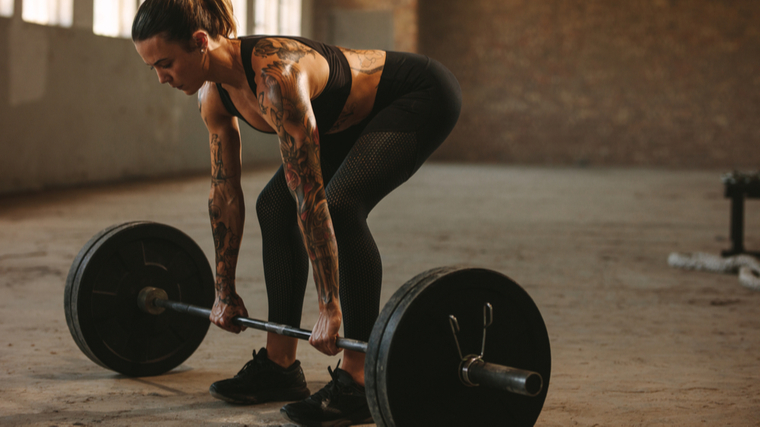
Set your feet slightly outside of hip-width and angle each foot slightly outwards. The bar should be above your foot, closer to the knot of your shoelaces than your toes. Pull your shoulder blades back and stand tall, lengthening your spine from the neck down.
Keep your knees very slightly bent. Push your hips back until your hands reach the bar on the outside of your legs. Maintain a neutral, not rounded, posture. Grab the bar with an overhand (palms down) grip. Bend your legs slightly more and secure your grip.
When viewed from the side, your hips and tailbone should be between your shoulders and your elbows, neither too high nor too low.
Form Tip: Because the barbell begins on the floor and weight plates are a standardized height, exceptionally taller or shorter lifters may not be ideally suited for the basic setup. The bar should begin in line with the lower shin. Adjust the bar’s starting position or your starting position using blocks, platforms, or stacked plates either under your feet (if you’re shorter) or under the bar (if you’re taller).
Step Two — Initiate the Pull to Lockout

As soon as you bend your legs and tighten your grip, press through your heels while remaining flat-footed. Your shoulders and hips should rise together; your body move as one single unit. Keep your shoulders pulled back. Engage your back muscles (lats) to prevent the bar from drifting towards your toes as it moves upwards.
As the bar passes your knees, contract your glutes to drive your hips forward while pulling your upper body back. In the top position, you should be standing fully upright with straight legs and the bar should be held against your body.
Form Tip: Because the barbell sleeve sits in the weight plate with a fraction of an inch of extra space, there’s a very slight delay in your body’s force being transferred to the actual load. You can take the “slack” out of the bar by beginning the lift extremely slowly until you feel the first contact between the barbell and the weight plates. It should take a fraction of a second. Follow it with a maximal production of force.
Step Three — Lower Under Control

From the locked out position, reverse the process to lower the weight. Push your hips backwards with slightly bent knees. Keep the bar in contact with your legs for as long as possible. As the weight passes your knees, bend your legs more to lower the weight to the floor.
Maintain a neutral, not rounded, back position for the entire lift. The bar should end up where it began, above your midfoot and not in front of your toes.
Form Tip: To perform an additional rep, you can either transition directly into pulling the next repetition (sometimes called “touch and go”) or you can release the bar, stand up, and repeat the entire setup process for each rep. The latter option allows more technique practice and greater power output, while “touch and go” reps can offer greater muscle-building benefit. (1)
Deadlift Mistakes to Avoid
Because the deadlift involves so many moving parts, there are several chances for mistakes to occur. Here are the most common issues to watch for.
Rounding the Back
Likely the most common problem during deadlifts is rounding the back, specifically the lower back. Performing deadlifts isn’t dangerous for your back; performing deadlifts incorrectly is dangerous for the back, just like performing any exercise is dangerous for a key body part involved in that exercise.
A rounded back compromises your ability to stabilize the body and transfer force from the lower body to the upper body. Pulling a deadlift with a rounded back will limit strength production and muscle recruitment, making it not only dangerous but less effective.
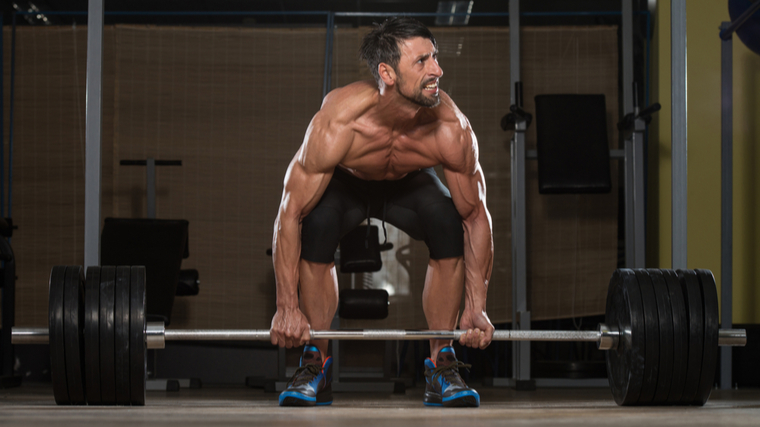
Failing to keep a neutral spine also exposes the vertebral discs to more direct stress, which may directly lead to a disc herniation or “slipped disc,” which can cause serious pain and require significant recovery time.
Avoid It: Begin each repetition with a neutral spine. Maintain body awareness to be conscious of any change in posture during the movement. Pinching the shoulder blades back, “puffing” the chest, and tensing the abs are effective cues to hold a strong spinal position.
If you find that you have trouble maintaining tense abs — also known as a braced core — you may need to address the issue by a) practicing bracing your core by deadlifting lighter weights and b) directly training your core more often.
Bending the Arms
Maintaining straight arms during the deadlift allows the strongest grip possible while also recruiting the entire musculature of the arms (biceps, triceps, and shoulders) to support the weight.
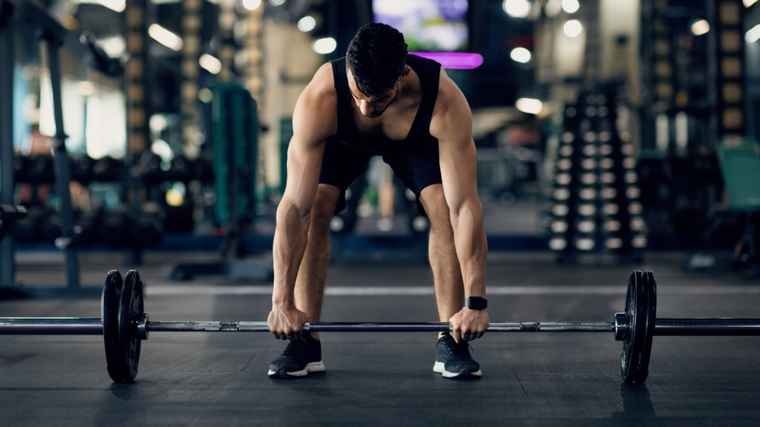
Pulling the bar with bent arms will limit overall strength and stability. More importantly, a bent arm puts the biceps muscle under more direct stress while in a weakened position, which can lead to a strain or a biceps tear.
This is one potential drawback to using a mixed grip (grabbing the bar with one hand palm-up and the other hand palm-down). While a mixed grip can reinforce grip strength, the palm-up arm is often in a slightly bent position, making it a higher risk technique.
Avoid It: When gripping the bar, flex the triceps of both arms to ensure straight arms prior to pulling the weight. Because the triceps function to extend the arm, they cannot maximally contract if the arm is bent.
Avoiding Lockout
Shortening the range of motion can reduce the effectiveness of many exercises. With the deadlift specifically, that often comes in the top position. Lifters are sometimes quick to get the weight off the ground and rush to return it back down without fully completing the movement.
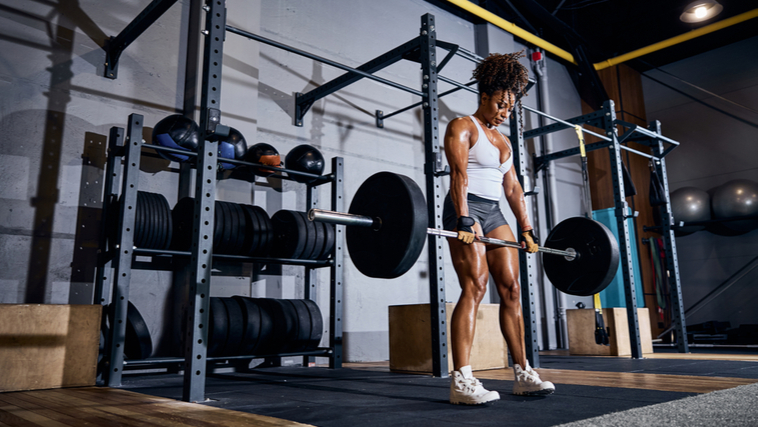
By skipping the lockout position, overall muscle recruitment is drastically reduced. The powerful muscles of the glutes are maximally recruited and fully contracted in the top position. Lockout is also the position which allows the majority of back muscles (lumbar spine, lats, and upper back) to become more highly activated.
Avoiding the locked out position also affects the transition between the lifting and lowering phases, making it more difficult to maintain proper form. This can make the descent of the weight less controlled and bring a higher risk of injury.
Avoid It: Complete each deadlift repetition in a fully locked out position, standing upright with your shoulders back and legs straight. To double-check your end position, squeeze your glutes tightly — pinch a quarter, crack a walnut, or turn a lump of coal into a diamond… choose your visualization.
Benefits of the Deadlift
The deadlift recruits multiple muscles in the upper and lower body, it can (eventually) be performed with seriously heavy weights which helps to develop total-body strength. Here’s why the deadlift can play a role in nearly any training program.
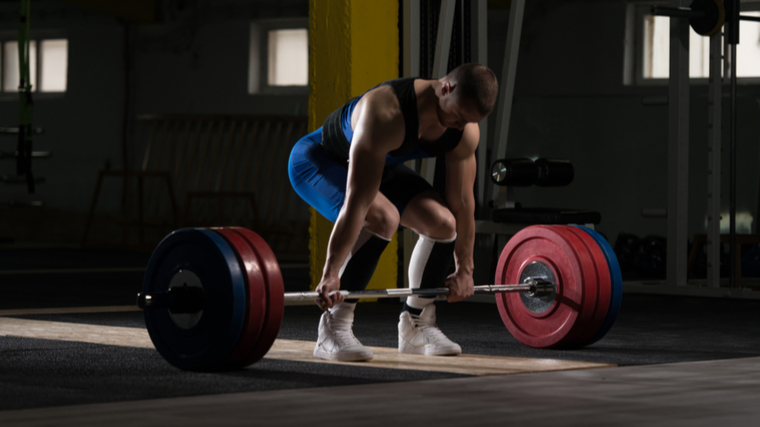
Training for Strength
The deadlift is where leverage, physics, and kinesiology meet to move big weights. It’s not uncommon for lifters to deadlift several hundred pounds within their first year of training, unlike most other exercises. The deadlift is a foundational movement to build a stronger back, legs, and core.
Training for Muscle
The more muscles recruited during an exercise, the greater potential for overall muscle growth. The deadlift significantly activates multiple muscles on the back, as well as the legs, shoulders, and arms. This is why the deadlift often plays a key role in muscle-building training plans.
Muscles Worked by the Deadlift
Because the deadlift requires force to be transferred from the feet through the entire body to the hands holding the weight, there are very few muscles which don’t get worked by a set of deadlifts. Here’s the list of muscles that do.
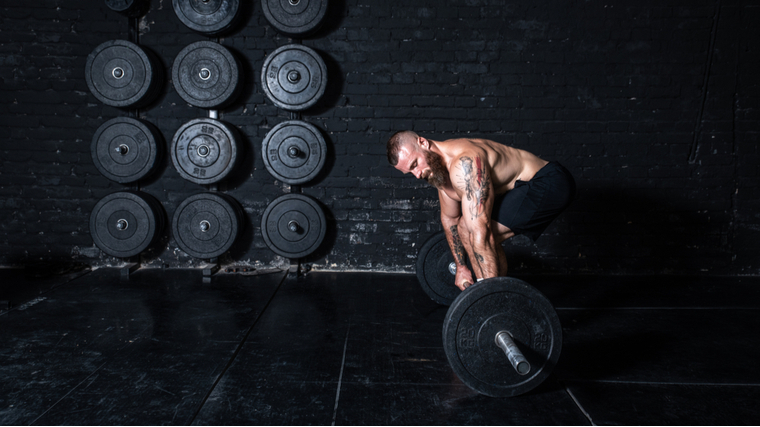
Hamstrings
The hamstrings are stretched in the bottom position of a deadlift, when your upper body is bent forward with bent legs, and contracted as you rise upwards. The hamstrings are responsible for hip extension, or straightening the leg in line with the body. The hamstrings also play a role in knee flexion (bending the leg), which is performed when lowering the weight under control.
Glutes
The glute muscles, being major muscles involved in hip extension, are heavily recruited during deadlifts. Performing the exercise with a full range of motion and complete lockout is necessary for maximum benefit and optimal glute recruitment.
Lats
The latissimus dorsi, or lats, are large muscles of the mid-back responsible for arm movement at the shoulder joint. The lats are recruited during the deadlift to maintain the bar’s position close to the body. The lats primarily act statically, without moving through any significant range of motion. However, they play an essential role in the deadlift.
Upper Back
The multiple muscles of the upper back including the trapezius, rear delts, teres, and rhomboids are worked statically to maintain a strong and stable position when lifting and lowering weight in the deadlift. Similar to the lats, the upper back doesn’t perform a significant range of motion, but the static contraction can be a significant stimulus for strength and growth.
Spinal Erectors
The erector spinae, or spinal erectors, are a twin column of muscles running the length of the spine. They play a key role in overall spinal stability and back health. The erectors operate to straighten the back and resist bending forward, both of which are necessary during a set of deadlifts.
Forearms
The forearm flexors and extensors are often overlooked by many lifters, but the deadlift is one of the few exercises to target them heavily. Specifically, the deadlift works the forearm flexors (on the underside of the forearm) to maintain a secure hold of the bar from the moment it’s lifted until it’s put down.
Because the forearm and gripping muscles are not frequently trained, the grip is often the first “weak link” in the movement and many lifters find their forearms fatigue before their legs or back.
Who Should Do the Deadlift
As a foundational exercise, the deadlift is a staple in many beginner programs to help develop a base of strength and muscles. Its benefits are significant enough that plenty of lifters well-beyond the beginner stage keep the deadlift in their workouts for the numerous benefits.
Strength Athletes
The deadlift is one of the “big three” powerlifting movements. For that reason, it’s often tested in strength competitions. Competitive powerlifters, of course, as well as strongmen and strongwomen. CrossFit athletes, more often known for Olympic weightlifting and “metcon”-style events, also rely on the deadlift as a basic test of strength.
Training for Muscle
As an exercise which recruits the back, shoulders, and legs, the deadlift is capable of stimulating growth in some of the largest muscles of the body. Although some of the activated muscles (like the back and shoulders) don’t undergo significant ranges of motion, the overall tension during the set is ample to trigger growth. (2)(3)
How to Program the Deadlift
The deadlift can be programmed in-line with a number of goals. However, because the deadlift incorporates a number of muscles throughout the body, overall recovery is essential for optimal results.
Heavy Weight, Low Rep
Big weights for a few reps is the tried and true approach for the deadlift. Three to five sets for three to five reps, taking three to five minutes between each set for maximum recovery. This workout requires plenty of hard work and yields plenty of strength.
Heavy Weight, Moderate Rep
Crank up the muscle-building potential of the deadlift by hitting four or five sets of six to 10 reps with up to two minutes between sets. This type of workout can make use of the “touch and go” method. Start in a proper starting position and repeat reps consecutively until the set is finished. Be sure to pull deliberately and avoid bouncing the bar off the ground between reps.
One High-Rep Set
Possibly the most intense way to train the deadlift is a workout most often associated with squats. One set of 20 reps, standing upright and completely resetting between each rep. This workout is often called “a widowmaker”. After one session, you’ll understand why. It’s a high intensity approach that builds strength, muscle, and conditioning.
Deadlift Variations
The standard deadlift, called the “conventional deadlift” is typically considered the most basic and effective starting point to deliver size and strength. Certain variations may be more appropriate for certain lifters due to their individual requirements (like injury history) or specific goals.
Sumo Deadlift
The most common alternative to the conventional deadlift is the sumo deadlift. Most distinguishable by the wide stance and close grip on the bar (often hip-width or closer).
The leg position of the sumo deadlift activates more quadriceps into the movement. (4) The body position also allows a more upright torso, which reduces lower back strain making it an effective option for lifters with back problems.
Semi-Sumo (Squat-Stance) Deadlift
A lesser-known barbell deadlift variation, the semi-sumo stance (sometimes called a squat-stance deadlift) is, essentially, a hybrid of the conventional and sumo technique.
The feet are set wider than conventional, but not as wide as sumo. Grip width is inside the legs, unlike the conventional deadlift, but not typically as close as a sumo grip. Semi-sumo allows a slightly more upright torso without requiring excessive hip mobility to get into a full sumo stance.
Trap Bar Deadlift
The trap bar deadlift, or hex bar deadlift, puts the lifter directly in the middle of the weight rather than pulling with a barbell in front of the body.
This dramatic shift in the center of gravity allows overall technique to change and significantly reduces strain on the lower back. It’s typically the most “low back friendly” deadlift variation for any lifter with pre-existing issues.
Deadlift Alternatives
Several simple adjustments to the basic deadlift technique can turn the exercise into a different variation providing specific benefits.
Romanian Deadlift
Maintaining slightly bent legs throughout the entire exercise significantly increases focus on the hamstrings and glutes with relatively less involvement of the core and upper body. (5) This makes the Romanian deadlift a popular and effective leg exercise to specifically target the hamstrings and glutes, especially because the bar isn’t often lowered to the ground in order to maintain tension on the target muscles.
The adjusted muscle recruitment also reduces the potential weight to be moved, making the Romanian deadlift less effective for sheer strength gains.
Rack Pull
The rack pull is performed with the bar starting at knee-level or higher, making the total range of motion significantly less than a full deadlift. One benefit of the shortened range of motion is the ability to move drastically more weight than pulling from the floor.
Combined with increased recruitment of the muscles of the back, the rack pull is an effective exercise for lifters aiming to improve their strength specifically in the top-half of the deadlift’s range of motion, where those muscles are significantly involved.
Single-Leg Deadlift
Performing a standard deadlift while using only one leg isn’t a circus act. It’s a highly effective exercise for building core strength, addressing muscle imbalances, and increasing athletic power. (6)
The single-leg deadlift decreases the lifter’s base of support but increases core recruitment for stability. The output on the working leg is also increased, making it an ideal choice for athletic strength and conditioning programs looking to build functional strength and speed.
FAQs
Why do some lifters drop the weight from the top of a deadlift?
It’s not uncommon to see strength athletes like powerlifters pull a heavy deadlift, lock it out, and then simply release the bar and let it seemingly free fall to the ground. While most strength sports’ rules require the bar to be “lowered under control”, dropping the bar can occur.
Lifting the weight (the concentric phase) is when the muscular force is produced. Lowering the weight (the eccentric phase) is when the muscle is stretched. The eccentric phase has been shown to be extremely useful for muscle growth. (7)
However, eccentrics performed with very heavy weights may also increase the risk of injury due to the stretched position. Unless you’re moving extremely heavy weights, focus on using a controlled eccentric without simply dropping the bar.
My grip fails before the set ends. Should I use straps or a mixed grip?
Your forearms are almost always going to be a limiting factor when deadlifting because they’re simply a much, much smaller muscle group compared to the back, glutes, or hamstrings being used to move the weight.
While grip strength will develop naturally over time, it’s not uncommon to use specific techniques to provide support to the weaker muscle groups in order to better focus on the target muscles. Using lifting straps on your heaviest or most challenging deadlift sets will provide a sufficient balance of needed support without detracting from natural grip strength development.
A mixed-grip should be used only by competitive powerlifters (since lifting straps are not allowed in competition) because it exposes one arm to an increased risk of strain and may lead to postural imbalances.
Is the deadlift good for building muscle or not?
The deadlift puts a number of large muscle groups under tension, which is associated with stimulating muscle growth. (8) However, because not all of these muscles go through a large range of motion, the deadlift isn’t always considered an effective choice for targeting specific muscles.
For example, to emphasize the hamstrings, a Romanian deadlift may be a better exercise choice. To emphasize the back, a pull-up can yield better specific results. However, if your training goals distinguish a difference between “building muscle” and “building body parts”, the deadlift can certainly be an efficient and effective exercise.
References
- Krajewski KT, LeFavi RG, Riemann BL. A Biomechanical Analysis of the Effects of Bouncing the Barbell in the Conventional Deadlift. J Strength Cond Res. 2019 Jul;33 Suppl 1:S70-S77. doi: 10.1519/JSC.0000000000002545. PMID: 29489730.
- Beggs, Luke Allen, “COMPARISON OF MUSCLE ACTIVATION AND KINEMATICS DURING THE DEADLIFT USING A DOUBLE‐PRONATED AND OVERHAND/UNDERHAND GRIP” (2011). University of Kentucky Master’s Theses. 87.
- Carbe, J., & Lind, A. (2014). A kinematic, kinetic and electromyographic analysis of 1-repetition maximum deadlifts.
- Escamilla, R. F., Francisco, A. C., Kayes, A. V., Speer, K. P., & Moorman, C. T., 3rd (2002). An electromyographic analysis of sumo and conventional style deadlifts. Medicine and science in sports and exercise, 34(4), 682–688. https://doi.org/10.1097/00005768-200204000-00019
- Martín-Fuentes I, Oliva-Lozano JM, Muyor JM. Electromyographic activity in deadlift exercise and its variants. A systematic review. PLoS One. 2020 Feb 27;15(2):e0229507. doi: 10.1371/journal.pone.0229507. PMID: 32107499; PMCID: PMC7046193.
- Diamant W, Geisler S, Havers T, Knicker A. Comparison of EMG Activity between Single-Leg Deadlift and Conventional Bilateral Deadlift in Trained Amateur Athletes – An Empirical Analysis. Int J Exerc Sci. 2021;14(1):187-201. Published 2021 Apr 1.
- Roig M, O’Brien K, Kirk G, Murray R, McKinnon P, Shadgan B, Reid WD. The effects of eccentric versus concentric resistance training on muscle strength and mass in healthy adults: a systematic review with meta-analysis. Br J Sports Med. 2009 Aug;43(8):556-68. doi: 10.1136/bjsm.2008.051417. Epub 2008 Nov 3. PMID: 18981046.
- Burd NA, Andrews RJ, West DW, et al. Muscle time under tension during resistance exercise stimulates differential muscle protein sub-fractional synthetic responses in men. J Physiol. 2012;590(2):351-362. doi:10.1113/jphysiol.2011.221200
Featured Image: UfaBizPhoto / Shutterstock
The post How to Do the Deadlift for Strength and Muscle appeared first on Breaking Muscle.





